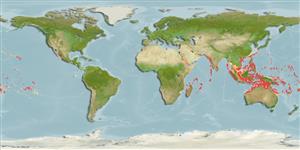Environment: milieu / climate zone / depth range / distribution range
Écologie
marin récifal; profondeur 6 - 65 m (Ref. 9710). Tropical; 30°N - 24°S
Indo-Pacific: Red Sea and East Africa (Ref. 2334) to the Line and Mangaréva islands, north to Japan, south to New Caledonia.
Taille / Poids / Âge
Maturity: Lm ? range ? - ? cm
Max length : 11.0 cm TL mâle / non sexé; (Ref. 48635)
Description synthétique
Clés d'identification | Morphologie | Morphométrie
Épines dorsales (Total) : 8; Rayons mous dorsaux (Total) : 9; Épines anales: 2; Rayons mous anaux: 8. Whitish with 5 horizontal stripes (brassy to dark brown in color); dark spot at base of middle caudal fin rays; fin rays light red (Ref. 2334). Greatest depth of body 2.7-3.2 in SL (Ref. 90102). Dorsal-fin rays VII-I, 9; anal-fin rays II, 8; pectoral fin rays 14; pelvic fin rays I, 5; pored lateral line scales 24; predorsal scales 4; circumpeduncular scales 12; total gill rakers 19, developed gill rakers 14; body white colored, with five poorly defined dark brown stripes on lateral surface of body, posterior end of third stripe reaching black spot on base of caudal fin; base of caudal fin with spot subequal in size to pupil (Ref. 93839).
Commonly found in clear-waters of seaward reefs; on reef crests and slopes, where usually shallow, and along deep drop-offs to 25 m (Ref. 48635). Feeds on polychaetes and other small benthic invertebrates at night; cryptic under ledges or in holes by day (Ref. 1602). Solitary or in small groups (Ref 90102).
Life cycle and mating behavior
Maturité | Reproduction | Frai | Œufs | Fécondité | Larves
Mouthbrooders (Ref. 240). Distinct pairing during courtship and spawning (Ref. 205).
Myers, R.F., 1991. Micronesian reef fishes. Second Ed. Coral Graphics, Barrigada, Guam. 298 p. (Ref. 1602)
Statut dans la liste rouge de l'IUCN (Ref. 130435: Version 2024-1)
Menace pour l'homme
Harmless
Utilisations par l'homme
Pêcheries: commercial
Outils
Articles particuliers
Télécharger en XML
Sources Internet
Estimates based on models
Preferred temperature (Ref.
123201): 25.3 - 28.8, mean 27.6 °C (based on 502 cells).
Phylogenetic diversity index (Ref.
82804): PD
50 = 0.5000 [Uniqueness, from 0.5 = low to 2.0 = high].
Bayesian length-weight: a=0.01380 (0.00754 - 0.02527), b=3.07 (2.91 - 3.23), in cm total length, based on LWR estimates for this species & Genus-body shape (Ref.
93245).
Niveau trophique (Ref.
69278): 3.3 ±0.32 se; based on food items.
Résilience (Ref.
120179): Haut, temps minimum de doublement de population inférieur à 15 mois (Preliminary K or Fecundity.).
Fishing Vulnerability (Ref.
59153): Low vulnerability (10 of 100).
Nutrients (Ref.
124155): Calcium = 131 [67, 209] mg/100g; Iron = 0.943 [0.552, 1.607] mg/100g; Protein = 18.5 [17.3, 19.7] %; Omega3 = 0.135 [0.077, 0.232] g/100g; Selenium = 36.9 [19.2, 70.5] μg/100g; VitaminA = 54.1 [15.5, 194.0] μg/100g; Zinc = 1.64 [1.10, 2.39] mg/100g (wet weight);
